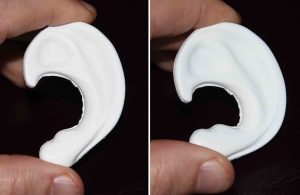Reconstruction of congenital ear defects, of which microtia is the most common, requires a framework to recreate the basic structure of the ear. Such framework recreations can be done either fabricating it from rib cartilage or an off-the shelf prefabricated implant. (porous polyethylene or Medpor) Each ear framework approach as its own advantages and disadvantages as well as their own surgical proponents.
The implant method has the major advantages of having an assured framework shape and does not require a donor site harvest. Because it is an implant there is a need for a more vascular soft tissue cover than just that of the skin which is provided by a concurrent pedicled fascial flap at the time of implant placement.
While often producing a nicely shaped ear, Medpor ear frameworks are known to have long-term complications. The very stiff material is quite different than the softer and more pliable natural ear cartilage. Our ears are exposed to lifelong stresses such as pressure and casual displacement/stretching which may create soft tissue breakdowns over the non-deformable stiff implant material. This raises the question of whether this is the best material for primary ear implant reconstruction as well as how to treat secondary ear implant exposures.
One new material combination for ear frameworks that I have found useful is that of a softer silicone material that has an ePTFE coating. The softer silicone framework feels much more similar to that of the natural ear, being with flexible but having high elastic deformation properties. The ePTFE coning allows for actual tissue adherence than silicone alone does not have.
In the primary ear reconstruction I would still lean towards using a fascial flap although it is unclear as to its absolute necessity. In the failed Medpor ear framework, removal and delayed reinsertion of the new ear framework alone be done.
Dr. Barry Eppley
Indianapolis, Indiana



